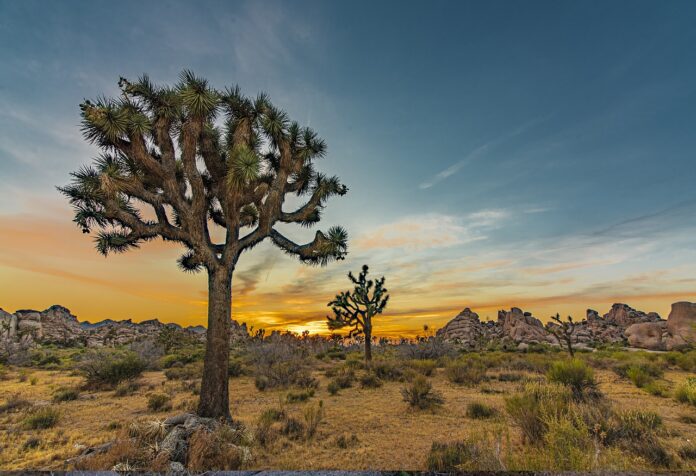The Joshua tree (Yucca brevifolia) is a tall, spiky evergreen plant that can grow up to 40 feet (12 meters). It is a member of the Agave family, with a thick, fibrous trunk and sprawling, spindly branches ending in clusters of sharp, sword-like leaves. The tree blooms in the spring, producing clusters of creamy-white flowers. Its unique, alien-like appearance has made it an iconic symbol of the Mojave Desert.
- Size: Can grow up to 40 feet (12 meters) tall.
- Leaves: Sharp, dagger-like, and spiny, ranging from 15–35 cm long.
- Flowers: Creamy-white, clustered, blooming typically in the spring.
- Bark: Rough and fibrous, helping the plant survive extreme heat and conserve moisture.
Habitat
The Joshua tree is native to the Mojave Desert in southwestern North America. It primarily grows in desert environments at altitudes of 2,000 to 6,000 feet (600 to 1,800 meters). These trees are well-adapted to dry, rocky, and sandy soils and thrive in areas with minimal rainfall.
- Regions: Found in California, Nevada, Utah, and Arizona.
- Climate: Hot, arid environments with extreme temperatures and low rainfall.
- Ecosystem: Provides habitat for various animals like desert wood rats, yucca moths, and birds of prey.
Interesting Facts
- Named by Mormon Settlers: The Joshua tree got its name from Mormon pioneers who thought the tree’s branches resembled the arms of the biblical figure Joshua raised in prayer.
- Extremely Long Life: Joshua trees can live for hundreds of years, with some thought to be over 1,000 years old.
- No Rings for Age Counting: Unlike many trees, Joshua trees don’t have growth rings, making it difficult to determine their exact age by typical methods.
- Pollination by Yucca Moth: The tree relies on a symbiotic relationship with the yucca moth, which is its sole pollinator. The moth lays its eggs inside the flowers while pollinating them, and the larvae feed on some of the seeds.
- Joshua Tree National Park: This iconic park in California, named after the tree, attracts millions of visitors each year, drawn to its unique desert landscape and wildlife.
- Climate Change Threats: Joshua trees are vulnerable to climate change, with rising temperatures and prolonged droughts threatening their survival. Studies suggest that they may be unable to survive in much of their current range by the end of the century.
- Joshua Tree National Park Vandalism (2019): During the U.S. government shutdown in 2019, several incidents of vandalism were reported in Joshua Tree National Park. Visitors were found cutting down Joshua trees, damaging the park’s delicate ecosystem. This act of destruction sparked widespread outrage.
- Wildfires and Tree Loss (2020): In 2020, a massive wildfire swept through parts of the Mojave Desert, including Joshua Tree National Park. The fire destroyed large swaths of Joshua tree forests, highlighting the increasing vulnerability of these trees to climate-related disasters.
- Joshua Tree as an Inspiration for Artists: Many artists and musicians, including U2 and desert-based visual artists, have drawn inspiration from the tree’s unique silhouette and spiritual symbolism. The Joshua tree’s connection to the American West and desert landscapes has cemented it as a cultural icon.
